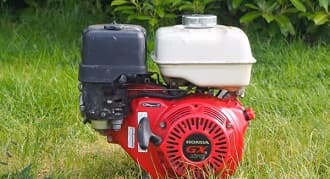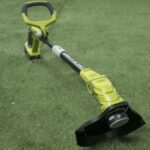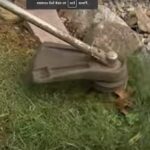As an Amazon Associate, this site earns commissions from qualifying purchases. For more information click here.
Honda supplies the engine for a lot of popular pressure washers made by Craftsman, Ryobi and other companies. If you have one of these models – or even an old one made by Honda – you might run across some problems when using it. Fortunately the solutions to these are straightforward.
A flooded engine, defective spark plug or dirty air filter can prevent a Honda pressure washer from starting. The carburetor might also need cleaning or a replacement to start up the engine.
Flooded Engine
A flooded engine means there is too much gas and not enough air. If you suddenly shut the engine off after starting it up cold, the system could get flooded with fuel. If there is too much the spark plug will not be able to ignite the engine.
There are many other reasons why a pressure washer engine gets flooded. Faulty fuel injection, damaged spark plug, a blocked carburetor or a rich air to fuel mix are among the causes.
The symptoms of a flooded engine include a powerful gas smell, longer crank times and stalling. Often the pressure washer will not start at all.
Solution. Turn the engine off for 15 minutes then start it again. Let it run for several minutes until the engine releases all the excess fuel. The smell may be overpowering and you will see a lot of smoke, but that is normal.
Once the smoke ceases, try the pressure washer again. If that does not work, check the spark plug, ignition coil, carburetor etc. Clean or replace them as necessary.
Replace the Fuel
Just like other pressure washers, Honda engine fuel have to be replaced every 30 days. If you don’t want to replace fuel that often, add stabilizer to prevent it from turning gummy. With the Stab-bil Fuel Storage Stabilizer, you can store a full tank with confidence. If you forgot, empty the tank and pour new fuel.
Solution. Gummy oil can spread throughout the engine and prevent the pressure washer from running. The solution is to replenish the fuel or add stabilizer. Either way that should be enough to prevent the engine from flooding.
Remember to clean or replace the engine parts mentioned above. Finally, you might want to adjust the fuel mix so it is leaner.
Check the Spark Plug
The spark plug got its name because it supplies the spark that starts a pressure washer engine. The ignition coil sends the spark to the plug which transmits it to the rest of the system.
If the spark plug is not working the motor will not start. This is also one thing to check if your pressure washer will not run with water on.
- Find the spark plug boot and disconnect it.
- Take out the spark plug and examine it.th Ram Pro Spark Plug tester can tell you if it is working or not. If it is covered with carbon deposit and dirt, wipe it clean. But if it is corroded or damaged, replace immediately.
- Pressure washers use specific types of spark plugs. Look up this up in your owner’s manual or the manufacturer site. Buy only the spark plug that is exactly like the current one.
Clean the Carburetor
A blocked carburetor can lead to engine flooding and cause the pressure washer to stall. The carburetor provides the air needed for ignition so if it is blocked, the fuel will not combust properly if at all.
Solution. Dirt and fuel sludge can spread over the carburetor so a cleanup is in order.
Remove the filter and clean it thoroughly. When you are done, add some starting fluid in the air intake port. Turn the engine on. There is a chance this will be enough to remove the gummy oil blocking the carburetor.
If the engine does not start, turn it off. Lift the carburetor from its casing and clean it. A really dirty carburetor has to be rebuilt. This can be a complicated process so you might consider taking the pressure washer to a repair center.
Overheated Engine
Honda pressure washers can overheat just like other engines. The solution for this is to allow the engine to cool off.
Pressure washers are often used during hot sunny days so the surface being cleaned dries quickly. However, high temperatures can take its toll on the engine. If you combine hot weather, a clogged air filter and a large area to wash, the engine will probably overheat.
The quickest fix is to turn the pressure washer off. When the engine cools, give it another try. Usually that is enough to get the Honda going. It would be even better if you clean the air filter and the rest of the engine to keep it going.
Nozzle and Hose Problems
If the pressure washer starts but there is low or no pressure, check the hose and nozzle. Here are some suggestions:
Make sure the pressure washer is securely connected to a water source. Turn on the water source first before the engine. If water flows from the hose, start the engine. If nothing comes out:
- The water source is not connected
- The hose is crimped
- There is a problem with the water spigot
Low water pressure. In some cases the engine will start but with very low pressure. There are a few reasons this can happen.
- The spray gun trigger might be damaged.
- The spigot or hose filter is dirty. This can happen with extensive use. Clean or replace the filter and try again.
- The nozzle setting is incorrect. Some nozzles have multiple configuration options, but choosing the wrong can lead to low pressure. If you set the nozzle to combine soap with water, it will generate low pressure.
Dropping pressure. There are three reasons this could occur.
The hose could be bent or twisted out of shape. This limits the volume of water that reaches the nozzle. Check the hose and straighten out any kink.
The hose might have a leak. A rip or tear leads to a water pressure drop, not to mention water wastage. If you are sure the hose does not have a kink and there is ample GPM, look for a possible leak.
The water supply is insufficient. Most pressure washers require 1.5 to 2.5 GPM, but check your owner’s manual to be sure. Next, measure the GPM coming from your water supply. If it is less than the minimum requirement the pressure washer will not function properly.

Engine Starts and Stops
There are many reasons why a pressure washer stalls, but for Honda engines it usually means a dirty air filter or a carburetor adjustment.
Dirty air filter. Air filters do exactly that, filter out dirt and debris to keep the engine humming. The rule of thumb is to replace the air filter every year, but regular cleaning can prolong its lifespan.
To clean the air filter, take out the filter and wipe it with a piece of cloth. You may wash it under a faucet or leave it in a container of soapy water.
Carburetor adjustment. The carburetor can be configured by adjusting the L, H and idle screws. The L is for low speed and the H for high speed. Use a screwdriver to adjust these settings until the engine is running continuously.
Adjusting the carburetor can be difficult. If you turn the adjustment screws too much it can have an adverse effect on the pressure washer. Take the machine to a service center if you are not sure.
Damaged Ignition Coil
The ignition coil is the part that ignites the spark plug which allows it to start the engine. If the pressure washer won’t start, check the ignition coil.
If the terminal pins are bent you can either replace the pin or the entire ignition coil. If it is dirty but undamaged, cleaning will be sufficient. If you are not sure if it is working or not, use an ignition coil tester. This device can determine if the coil is still usable or not.

I love the outdoors and all the tools for maintaining gardens, yards and lawns. The only thing I am more passionate about is sharing what I know about garden and outdoor equipment.


